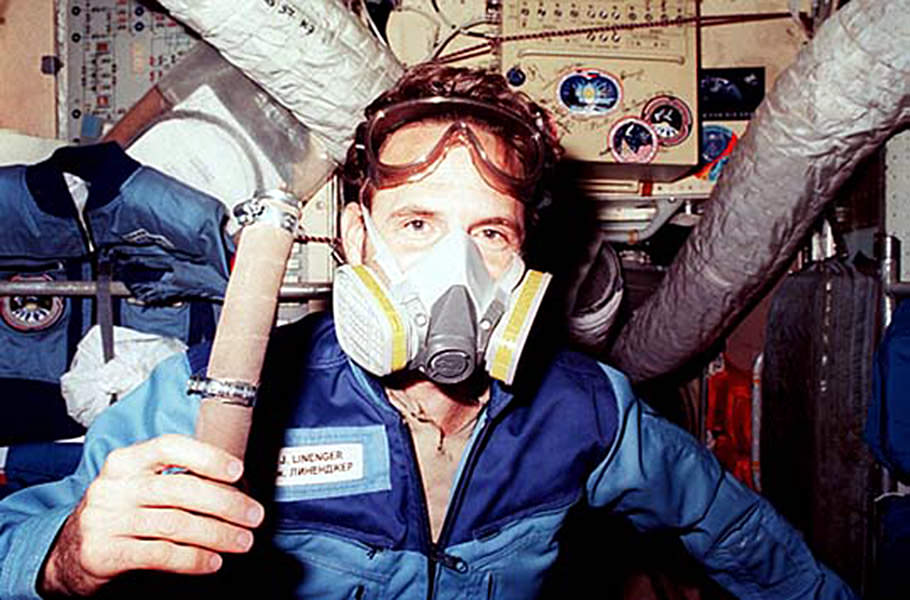Sixteen years ago, a fire on the Russian space station Mir erupted after a cosmonaut routinely ignited a perchlorate canister that produced oxygen to supplement the space station’s air supply. Jerry Linenger, an American astronaut aboard Mir at that time, wrote about the incident that occurred on February 24, 1997 in his memoir Off the Planet:
As the fire spewed with angry intensity, sparks – resembling an entire box of sparklers ignited simultaneously – extended a foot or so beyond the flame’s furthest edge. Beyond the sparks, I saw what appeared to be melting wax splattering on the bulkhead opposite the blaze. But it was not melting max. It was molten metal. The fire was so hot that it was melting metal.
Linenger famously had some trouble donning gas masks, which kept malfunctioning, but he and the rest of the crew managed to put out the blaze before it spun out of control. The cause was traced to a fault in the canister.
Mir itself was deorbited in 2001, but the fire safety lessons are still vivid in everyone’s mind today.

NASA fire expert David Urban told Universe Today that a fire is among the most catastrophic situations that a crew can face.
You can’t go outside, you’re in a very small volume, and your escape options are limited. Your survival options are limited. That space can tolerate a much smaller fire than you can tolerate in our home. The pressure can’t escape easily, and the heat stays there, and the toxic products are there as well.
Urban, who is chief of the combustion and reacting systems branch of the research and technology directorate of the NASA Glenn Research Center, said NASA and Russia have learned several things from the incident that they have implemented on the International Space Station today:
– Changing fabrication procedures for the canisters. NASA officials and their Russian counterparts “took a good hard look” at the canisters and determined they were still the best solution given their modest weight and easy portability. They did, however, put stricter guidelines into the fabrication in the Russian facility. “The most likely cause was contamination during assembly of the cassette, the cartridge that contains the perchlorate. So, much stronger control there and more testing of the units as they make them. ”
– Better insulation. Urban noted the canisters are now in specially designed cases, a sort of high-temperature insulation package that can absorb the “blow torch effect” that happens if a unit fails. “It protects the rest of the vehicle … like a fire in a fireplace.”
– Clearing the way. Just before the Mir fire happened, the crew happened to clean up trash from the immediate area near the faulty canister. The procedure was just a coincidence, but it could have ended up saving the ship, Urban said. Today’s space station crews are very careful to keep a buffer between the canisters on board and any items. “In the shuttle era, it was different because it came back in 16 days or less. The space station or Mir, it’s like your house. You can’t let clutter accumulate. We’ve learned a lot in Mir about how to manage a long-duration vehicle.”
– Keeping up with the latest research. There are, in fact, two fire suppression systems on the International Space Station: a water foam system in the Russian sections, and a carbon dioxide system in the United States area. NASA is now working on a more modern “water mist” fire suppression method, based on an ongoing trend seen protecting terrestrial areas such as electronics and shipping rooms. This system emits fine particles, sort of like a sprinkler, that are just tens of microns across and act almost like a gas. Urban said the system is late in the design review part of development and should be ready for use on station within the next couple of years.
One 2011 NASA report on the incident also highlighted the importance of emergency preparation and safety drills to mitigate fires as they happen. “More effective warning systems could save several seconds of reaction time, which, in a crisis, could mean the difference between success and failure,” it stated. You can read the rest of that report here.


Was this the fire in a side area? The firefighting plan was to shut the door and open the port to remove all the oxygen. he problem was that the door could not be closed due to pipes passing through the door way.